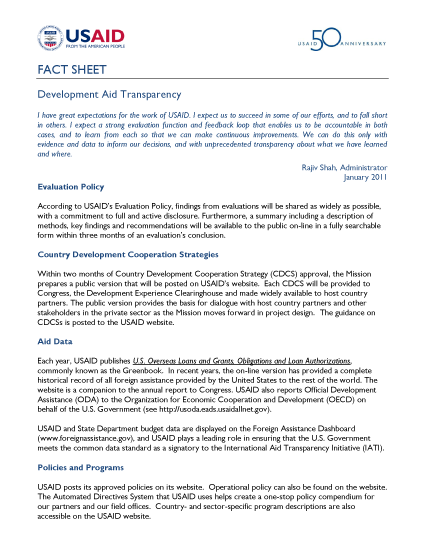I have great expectations for the work of USAID. I expect us to succeed in some of our efforts, and to fall short in others. I expect a strong evaluation function and feedback loop that enables us to be accountable in both cases, and to learn from each so that we can make continuous improvements. We can do this only with evidence and data to inform our decisions, and with unprecedented transparency about what we have learned and where.
Rajiv Shah, Administrator
January 2011
Evaluation Policy
Aid Transparency - USAID Fact Sheet ![]() (pdf - 165k)
(pdf - 165k)
According to USAID's Evaluation Policy, findings from evaluations will be shared as widely as possible, with a commitment to full and active disclosure. Furthermore, a summary including a description of methods, key findings and recommendations will be available to the public on-line in a fully searchable form within three months of an evaluation’s conclusion.
Country Development Cooperation Strategies
Within two months of Country Development Cooperation Strategy (CDCS) approval, the Mission prepares a public version that will be posted on USAID’s website. Each CDCS will be provided to Congress, the Development Experience Clearinghouse and made widely available to host country partners. The public version provides the basis for dialogue with host country partners and other stakeholders in the private sector as the Mission moves forward in project design. The guidance on CDCSs is posted to the USAID website.
Aid Data
Each year, USAID publishes U.S. Overseas Loans and Grants, Obligations and Loan Authorizations, commonly known as the Greenbook. In recent years, the on-line version has provided a complete historical record of all foreign assistance provided by the United States to the rest of the world. The website is a companion to the annual report to Congress. USAID also reports Official Development Assistance (ODA) to the Organization for Economic Cooperation and Development (OECD) on behalf of the U.S. Government (see http://usoda.eads.usaidallnet.gov).
USAID and State Department budget data are displayed on the Foreign Assistance Dashboard (www.foreignassistance.gov), and USAID plays a leading role in ensuring that the U.S. Government meets the common data standard as a signatory to the International Aid Transparency Initiative (IATI).
Policies and Programs
USAID posts its approved policies on its website. Operational policy can also be found on the website. The Automated Directives System that USAID uses helps create a one-stop policy compendium for our partners and our field offices. Country- and sector-specific program descriptions are also accessible on the USAID website.








Comment
Make a general inquiry or suggest an improvement.